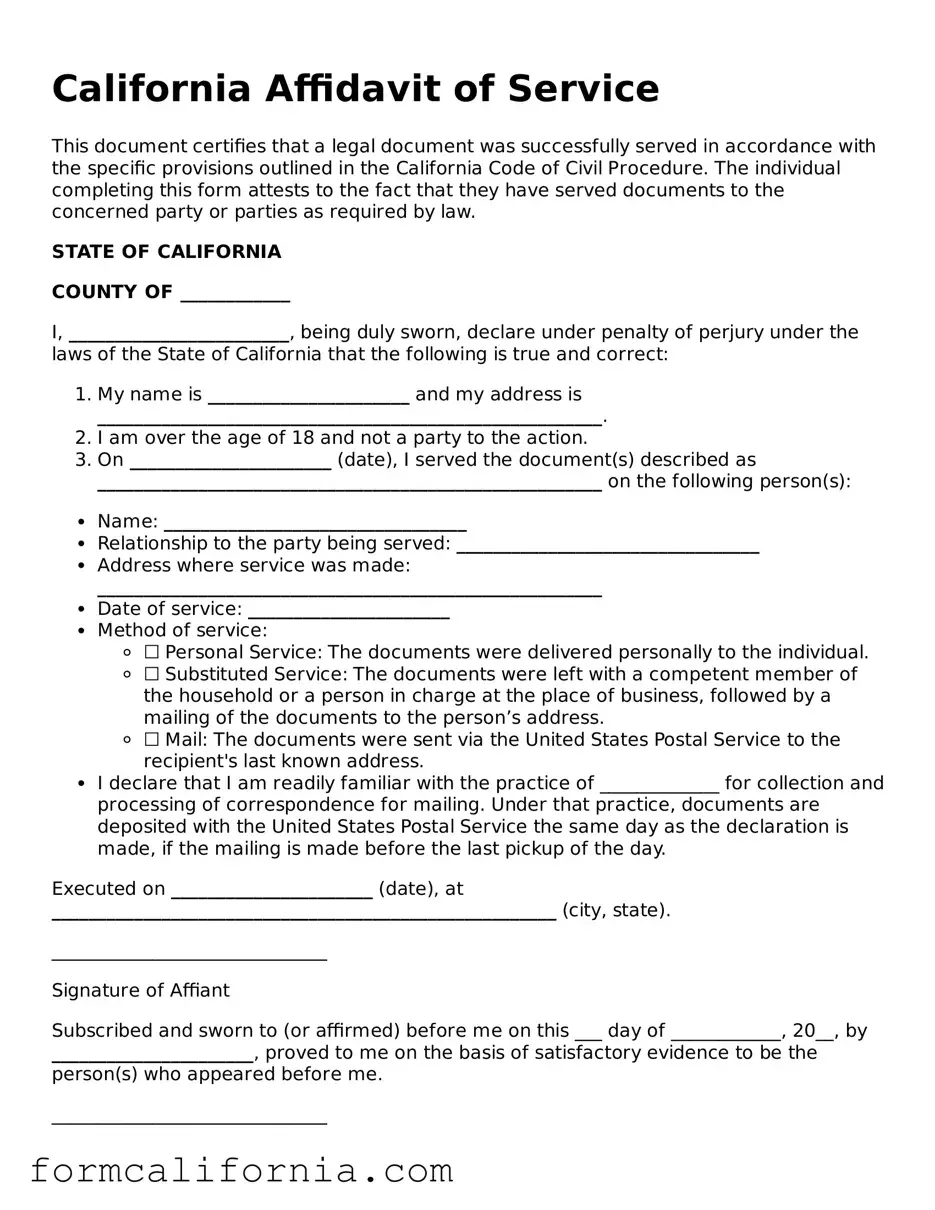What is a California Affidavit of Service?
An Affidavit of Service, in California, is a legal document used to verify that a legal document has been properly delivered to a party involved in a legal proceeding. It is a sworn statement, typically from the process server, confirming the details of the delivery, such as the time, place, and manner of service. This affidavit is a crucial piece of the legal process, ensuring all parties receive the necessary documents to participate in legal actions fully.
When is an Affidavit of Service required in California?
In California, an Affidavit of Service is required anytime a legal document needs to be formally served on a party involved in a legal case. This includes, but is not limited to, divorce papers, summonses, complaints, and other court communications. It must be filed with the court to prove that the party has been notified of the legal proceedings against them, which is a fundamental part of their due process rights.
Who can serve legal documents and complete the Affidavit of Service in California?
In California, legal documents must be served by someone who is not a party to the case and is at least 18 years old. This can be:
-
A professional process server
-
A sheriff or marshal
-
A friend or relative who meets the requirements
Once the documents are served, whoever served them must complete the Affidavit of Service, sign it in front of a notary, if applicable, and then file it with the court.
The California Affidavit of Service contains specific details to certify the service of documents. This generally includes:
-
The name of the person serving the documents
-
The type of legal document served
-
The method of service used (personal, substituted, etc.)
-
The date, time, and location where the documents were served
-
The name and description of the person who received the documents
-
Any other details related to the service process
This comprehensive document plays a pivotal role in ensuring the transparency and fairness of the legal proceedings.
How is the Affidavit of Service filed with a California court?
After the legal documents are served, the completed Affidavit of Service needs to be filed with the clerk of the court handling the case. This can typically be done by:
-
Hand-delivering it to the court
-
Mailing it to the court, if permitted
-
Filing it electronically, where available
The exact procedure may vary depending on the county and the specific court, so it's advisable to check the court's requirements beforehand.
Is there a deadline for filing an Affidavit of Service in California?
Yes, there is a deadline for filing an Affidavit of Service in California, which can vary depending on the type of legal document served and the specific requirements of the court. Generally, it must be filed within a reasonable time after service, often before the date of the next scheduled court hearing. Failure to timely file the affidavit may affect the legal proceedings, including potential delays or the inability to proceed with the case.
What happens if an Affidavit of Service cannot be filed in California?
If an Affidavit of Service cannot be filed – perhaps because the party could not be served – the serving party must inform the court and seek guidance. Options may include:
-
Applying for an extension of time to serve the documents
-
Seeking permission for an alternate method of service
The court's decision will depend on the circumstances, but the inability to serve a party does not necessarily halt the legal process.
Can an Affidavit of Service be contested in California?
Yes, an Affidavit of Service can be contested in California. If the receiving party believes the affidavit is incorrect or fraudulent – for instance, claiming documents were served when they were not – they can file a motion to quash the service with the court. This typically requires a hearing where both sides can present evidence. If the court finds the affidavit to be false, it can lead to legal consequences for the person who filed it and may require the service process to be redone.
How does electronic service affect the Affidavit of Service?
With the increasing acceptance of electronic service (e-service) in California courts, the process for Affidavits of Service has adapted accordingly. When documents are served electronically, the Affidavit of Service should detail the electronic delivery method, the email address or other electronic means used, the date and time of service, and confirmation of receipt if applicable. As with traditional service, this affidavit must be filed with the court to confirm service. The rules surrounding e-service ensure that the process is as transparent and reliable as traditional methods.
Are there any circumstances where an Affidavit of Service is not required in California?
While an Affidavit of Service is generally required for most formal services of legal documents, there are exceptions. For instance, when both parties agree to waive formal service, or in cases where legal documents are exchanged informally with the acknowledgment of receipt. However, even in these situations, it's often advisable to have some form of written acknowledgment to avoid disputes later in the legal process. Nonetheless, understanding the specific circumstances and requirements of your case is crucial, and consulting with a legal professional is always recommended.
